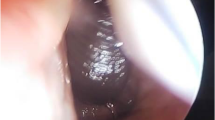Abstract
The aim of this study is to report unusual cause of epistaxis due to leech infestation in nose in hilly area and its management. The study was carried out for a period of 4 years (2008–2012) in a secondary level hospital in hilly area of Darjeeling, West Bengal, India with data collected from the OPD and Emergency register of the patients. This retrospective case series consisted of six cases. All the cases presented with unilateral recurrent epistaxis and foreign body nose. Anterior rhinoscopy revealed fleshy greenish brown mobile mass inside the nasal cavity which was removed by forceps. The animate foreign body was identified as leech in all the cases. To conclude, in hilly areas leech infestation can present as animate foreign body in nose and it should be considered as important cause of epistaxis.

Similar content being viewed by others
References
Sarathi K (2011) Nasal leech infestation causing persistent epistaxis. J Emerg Trauma Shock 4(3):413–414. doi:10.4103/0974-2700.83875
Golz A, Zohar S, Avraham S, Joachims HZ, Danino J, Merzbach D (1989) Epistaxiscaused by leeches. Harefuah 117(5–6):141–143
Satyawati SSK, Dass A (2002) Multiple live leeches from nose in a single patient—a rare entity. Indian J Otolaryngol Head Neck Surg 54(2):154–155. doi:10.1007/BF02968741
Payton B (1981) In: Kenneth M, Nicholls J, Stent G (eds) Neurobiology of the leech. Cold Spring Harbor Laboratory, New York, pp 7–26. ISBN 0-87969-146-8
Buchsbaum R, Buchsbaum M, Pearse J, Pearse V (1987) Animals without backbone (3rd ed). The University of Chicago Press, Chicago, pp 312–317. ISBN O-226-07874-4
Maliki O, Aderdour L, Hassani R, Rouchdi Y, Nouri H, Raji A (2010) Leeches of the upper aerodigestive tract. Rev Stomatol Chir Maxillofac 111(4):193–195. doi:10.1016/j.stomax.2010.06.005
Fogden S, Proctor J (1985) Notes on the feeding of land leeches (Haemadipsa zeylanica Moore and H. picta Moore) in Gunung Mulu National Park, Sarawak. Biotropica 17(2):172–174
“Leeches” De Brain Debrain. Retrieved 21 Feb 2013
Raza SN, Shabbir SM, Anwar-ul-Haq S (2006) Leech infestation and its association with water drinking habits. J Coll Physicians Surg Pak 16(3):175–178
Chen WC, Chien CY, Yang CH, Li JH, Hwang CF (2010) Nasal leech infestation: report of seven leeches and literature review. Eur Arch Otorhinolaryngol 267(8):1225–1229. doi:10.1007/s00405-009-1188-0
Ghimire A, Acharya A (2008) Unusual cause of unilateral epistaxis: nasal leech infestation. JNMA J Nepal Med Assoc 47(169):38–40
Saki N, Rahim F, Nikaghlagh S, Saki G (2009) Meta analysis of the leech as a live foreign body: detection, precaution and treatment. Pak J Biol Sci 12(24):1556–1563
Chow CK, Wong SS, Ho AC, Lau SK (2005) Unilateral epistaxis after swimming in a stream. Hong Kong Med J 11(2):2–110
Waleem SS, Ullah S (2010) Nasal Hirudiniasis—an unusual cause of epistaxis. J Ayub Med Coll Abbottabad 22(1):46–48
Siddiqui TS, Qureshi I, Mufti TS (2005) Nasal leech—a rare cause of severe anemia. J Ayub Med Coll Abbottabad 17(3):82–83
Bilgen C, Karci B, Uluöz U (2002) A nasopharyngeal mass: leech in the nasopharynx. Int J Pediatric Otorhinolaryngol 64(1):73–76
Author information
Authors and Affiliations
Corresponding author
Rights and permissions
About this article
Cite this article
Dutta, S., Saha, S. & Pal, S. Epistaxis Due to Leech Infestation in Nose: A Report of Six Cases and Review of Literature. Indian J Otolaryngol Head Neck Surg 68, 42–45 (2016). https://doi.org/10.1007/s12070-014-0728-0
Received:
Accepted:
Published:
Issue Date:
DOI: https://doi.org/10.1007/s12070-014-0728-0




